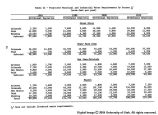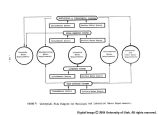| OCR Text |
Show PART II PRESENT STATUS Livestock water requirements depend upon climatic factors, such as temperature and precipitation; number, species, age and condition of the animal; nature of the diet; and upon water management practices (22) (32). Livestock water requirements include water consumed by the animals plus water evaporated from stock watering ponds. For 1965, 11,000 acre- feet was consumed by animals and 23,900 acre-feet evaporated from 22,000 stock ponds in the Region. The total depletion of 34,900 acre-feet is more than all other municipal and industrial requirements combined. This comparison dramatizes the rural character of the study area. Further, the livestock depletion was about 28 percent of the 1965 Regional M&I withdrawal requirements. Governmental Water Use Governmental water requirements were the smallest of the five water- use categories, with only 10,700 acre-feet withdrawn in 1965. Depletions were 1,000 acre-feet, or 9 percent of the withdrawal requirements. Governmental requirements for water result from a wide range of federal, state, and local governmental activities. A variety of factors affect these requirements; size of cities and climate are probably the most significant factors, and cost of water the least significant (4). Some of the governmental uses of water include supplies for: public build- ings such as post offices, schools, hospitals, and office building; mili- tary installations; watering public lawns, parks, and golf courses; fire control; street cleaning; public swimming pools; and various research activities. Governmental water requirements are seasonal in nature and are largest during the summer months. Commercial and Other Water Use Withdrawal requirements for the commercial and other water uses were 14,400 acre-feet in 1965; the depletions were 5,700 acre-feet, or 40 per- cent of the withdrawals. The Upper Main Stem Subregion had the largest subregional commercial and other water requirements. Commercial requirements for water refer to the requirements of the trades and services industries. These requirements depend primarily upon three factors: size of resident population, its per capita income, and the extent to which commercial services are provided for a transient population (4). This latter factor is particularly relevant in the Upper Colorado Region which supports a significant tourist industry. Commercial uses of water are varied and closely approximate domestic uses of water. The use of water in commercial establishments such as 12 |

















































































